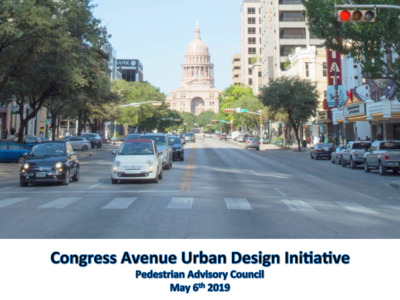Item 2c - Pedestrian Advisory Council recommendations — original pdf
Backup

The$proposed$Amenity$Area$in$the$Congress$Avenue$Urban$Design$Ini9a9ve$opens$up$many$possibili9es$on$Congress$ Congress$is$already$evolving…$Pocket$Pa9os$are$appearing$ …the$2018$PARK(ing)$Day$event$received$many$applica9ons$on$Congress$ We$could$use$exis9ng$parking$spaces$on$Congress$as$nonIcar$“flexiIspaces”$for:$commerce…$ …and$more$crea9ve/uncommon$uses$such$as$entertainment,$art,$relaxa9on$spaces,$and$bathrooms$ These$kiosks$are$used$at$the$Winter$Village$event$in$Bryant$Park,$midtown$ManhaUan$ These$kiosks$can$house$uses$such$as$small$businesses,$and$they$define$space$well$ Such$kiosks$could$be$used$for$many$purposes$on$Congress’s$flexiIspaces$I$eg.$tourist$info,$restaurants,$mee9ng$rooms,$etc.$ Fully$developing$the$Amenity$Area$could$eventually$produce$an$invi9ng$pedestrian$realm$as$pictured$above$ San$Francisco’s$plans$for$its$main$street$would$ban$all$private$cars…$ …So$we$can$certainly$be$more$progressive$than$just$removing$one$vehicle$lane$on$Congress$ For$instance,$a$4Ilane$street$creates$significant$amounts$of$new$space$for$pedestrians,$flexiIspaces,$and$bike$lanes$ Congress$is$clearly$a$great$place$for$street$events.$We$should$encourage$more$of$these$on$Congress$ Detroit’s$annual$Winter$Market$is$a$model$for$tes9ng$a$street$as$a$pedestrianIonly$space$for$weeks$or$longer$ This$“Fes9val$Street”$in$Portland$OR$is$designed$to$make$closing$the$street$to$traffic$easy$ Pedestrians$and$bikes$can$mix$when$the$street$is$properly$designed$ Pocket$Pa9os$$+$$PARK(ing)$Day$$+$$Street$events$$=$…?$We$don’t$know$where$an$evolving$Congress$will$take$us$but$we$should$allow$it$to$evolve$to$show$us.$ Many$worldIclass$ci9es$turned$autoIstreets$into$pedestrianIonly$public$spaces.$For$example,$New$York$City$in$the$past…$ New$York$City$today…$ CharloUesville,$Virginia$in$the$past…$ CharloUesville,$Virginia$today…$ Boulder,$Colorado$in$the$past$ Boulder,$Colorado$today…$ And$perhaps$one$day,$Congress$Avenue$could$become…$ A$carIfree$public$space.$More$informa9on$on$these$ideas:$Pedestrian$Advisory$Council’s$May$2019$recommenda9on$ Pedestrian Advisory Council (PAC) Recommendation: Congress Avenue Urban Design Initiative WHEREAS, the purpose of the Pedestrian Advisory Council (PAC) is to advise the City of Austin on pedestrian planning, policy, design, funding, education, and enforcement efforts regarding the creation, maintenance, and operation of pedestrian facilities; WHEREAS, Congress Avenue is the iconic main street of Texas which should be a thriving social, civic, and commercial center but which is currently underperforming in these regards; WHEREAS, much of Congress is a poor commercial environment characterized by long blank walls, large single-use buildings with few entrances, and street-facing parking lots; WHEREAS, Congress should be a people-first street but most space is currently allocated to automobiles, even though it is not an important cross-town route and other arterial streets are located close by, which induces driving and encourages high traffic speeds while endangering pedestrians and other road-users and much or all of this road space would be better utilized for more socially and economically productive purposes; WHEREAS, many world-class cities feature centrally-located car-free public spaces in their downtown areas to facilitate basic human needs such as people-watching, making and meeting with friends, enjoying activities and culture, engaging in political activities, and shopping; WHEREAS, no matter what their age, physical ability, income level, and cultural background, all people should be equally able to safely and conveniently visit and linger on Congress Avenue and partake in a rich variety of experiences; WHEREAS, infrastructural and regulatory changes would allow a diverse array of community members to have a “right to the city” to test and integrate new ideas and perspectives on Congress on an ongoing basis, allowing the street to evolve constantly and gradually over time, such changes including reallocating travel lanes to other uses and sidewalk-area experimentations; WHEREAS, most effectively improving Congress Avenue also requires changes to the surrounding area, as well as on Congress itself; WHEREAS, a comprehensive parking strategy would utilize parking more productively near Congress and the car parking spaces on Congress would be better used for other purposes; WHEREAS, converting downtown streets from one-way to two-way can improve pedestrian safety, slow traffic speeds, reduce vehicle miles traveled, and improve business; WHEREAS, certain areas of Congress are dangerous, especially for pedestrians and bicyclists, and warrant near-term safety fixes; WHEREAS, the Congress Avenue Design Initiative has made substantial progress in identifying a compelling vision for Congress and is an important project whose outcome will be crucial for Austin’s future; NOW, THEREFORE, BE IT RESOLVED, the Pedestrian Advisory Council recommends the following elements be included in the Congress Avenue Urban Design Initiative: • The amenity area proposed in the Design Initiative feature “flexi-spaces”, of at least the same number as current parking spaces, that contain small kiosks and other temporary structures and which can be used for a curated balance of revolving commercial and non-commercial purposes such as art galleries; performance spaces; children’s activities; public gathering spaces and bookable meeting rooms; visitor information; police services; and cafes, restaurants, and other types of businesses • Prior to the installation of flexi-spaces, fund a PARK(ing) Day program that includes temporary conversion of all parking spaces on Congress to other uses • To maintain continuity with the proposed number of vehicle lanes on the Ann W. Richards Congress Avenue Bridge, the number of vehicular lanes on the rest of Congress to the north be reduced or reconfigured such that space is reallocated to wider sidewalks, a wider amenity area, protected bicycle lanes, and other elements • Encourage regular street events and fund a City-organized Open Streets program that test the degree to which a portion of Congress could function as a permanent or semi-permanent car-free space by converting the blocks between 7th and 11th Streets to a “festival streets” design and by creating regulations that reduce the burdens of organizing street events and encourage such events to occur more often, for a broader range of time periods, and with wider programmatic variety • On Congress between 10th and 11th Streets, work with the State of Texas to replace the rows of parking spaces closest to the sidewalk with small street-facing sidewalk-accessible building structures to be used for a variety of purposes or in some other way activate the street to a more optimal use than a surface parking lot • Discourage vacant properties and storefronts on Congress • The City of Austin execute a comprehensive downtown parking strategy that integrates the PAC’s parking recommendations made in February 2019 • All streets identified in the City of Austin Downtown Austin Master Plan for one-way to two-way conversion undergo such a conversion • Install public restrooms every couple of blocks • Funding for upgrading Congress be obtained and allocated in portions that reflect certain priorities, such as near-term safety improvements being made as soon as possible on Congress at any location that is unsafe and/or where death or serious injuries have occurred, conversion of all parking spaces into car-free flexi-spaces, and regulatory changes to encourage street events. Date of Approval: May 6, 2019 Vote: 7 - 0 with Mulcahy absent Attest: Jay Blazek Crossley, Pedestrian Advisory Council Chair